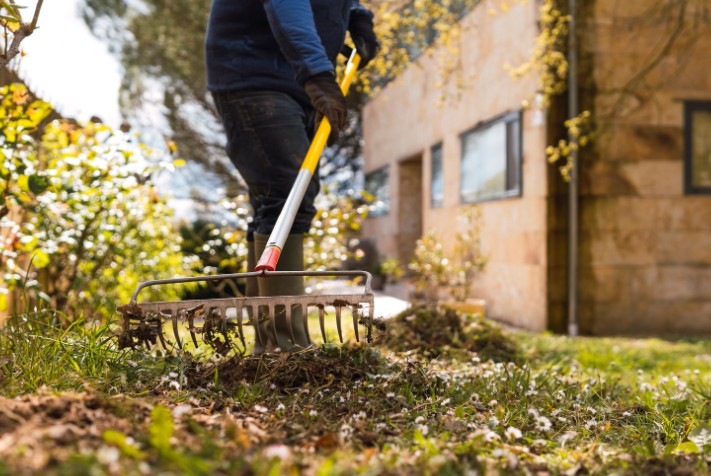When I first looked at my bumpy, uneven garden, I knew I had two choices: either call in expensive machinery or roll up my sleeves and do it myself. I chose the latter — and I haven’t looked back since.
If you’re like me, looking for a way on how to level a garden without a digger, you’re in the right place. Whether you’re planning to lay new turf, build a patio, or simply want a more usable and attractive outdoor space, this guide walks you through the process.
No need for heavy machinery — just a few tools, a bit of effort, and a DIY spirit.
How to Level a Garden Without a Digger? – Step-by-Step Guide
Levelling a garden manually may sound intimidating, but it’s a completely manageable project if broken down into clear, achievable steps. When I decided to take on the task myself, I found it was all about having the right plan, tools, and attitude. Here’s how I did it — and how you can too.
Step 1: Clear the Area
Before anything else, I started by preparing the surface:
- I removed any turf, weeds, dead plants, stones, and other debris.
- You can use a spade to lift the turf and a garden fork to uproot any deep-rooted weeds.
- If you’re planning to reuse the turf, stack it grass-side down in a corner and keep it moist.
Tip: Don’t skip this step — leftover roots and rocks will make it harder to get a smooth finish later on.

Step 2: Loosen the Soil
Once the area was cleared, I needed to break up the existing soil:
- I used a garden fork to loosen compacted ground, especially where there were high spots I planned to redistribute.
- For large areas, a manual rotavator can save time (and your back).
- The goal here is to create a workable, fluffy soil structure that can be easily moved and levelled.
This also helped improve drainage and aeration in the soil — a bonus for any plants or turf you’ll add later.
Step 3: Set Your Reference Level
This is where the real planning comes into play. I needed to know what “level” actually meant in my garden.
- I drove wooden stakes into the corners of the garden and ran string lines between them.
- I used a spirit level to check that the string was perfectly horizontal.
- Then I measured the distance between the string and the ground at various points to see where the land was uneven.
Pro Tip: If you don’t have a long spirit level, place a small one on a straight timber board to cover longer spans.
This gave me a clear visual map of the highs and lows in my garden.
Step 4: Redistribute the Soil
Now the real work begins.
- I used a shovel to move soil from the higher areas to the lower ones.
- Then I spread the soil out using a levelling rake, which has wider and flatter teeth than a standard rake.
- I worked in sections, always referring back to my string lines to stay on track.
If you’re dealing with deep dips, you’ll probably need to add topsoil. I mixed mine with compost to improve fertility and structure.

Step 5: Compact the Soil
A crucial step — and one many people skip.
- I lightly watered the soil to help it settle.
- Then, I compacted the surface manually using a tamper (a heavy, flat-bottomed tool). In areas where I didn’t have one, I simply placed a wooden board down and walked across it carefully to press the soil in.
- If you skip compacting, your garden may sink unevenly over time, especially after rain.
Alternative Tool: If you have one, a manual lawn roller is great for this — just make sure the soil isn’t too wet or too dry.
Step 6: Let the Ground Settle
This is the step that taught me patience.
- After compacting, I let the ground sit undisturbed for at least 5–7 days.
- I lightly watered the area once or twice to simulate rainfall, helping the soil compact naturally and expose any new low spots.
Once settled, I made small adjustments by topping up any sunken areas with a fine layer of topsoil and gently raking it level.
Step 7: Final Levelling and Raking
Now, with most of the heavy work done:
- I gave the whole area a final rake, working in opposite directions to break up clumps and get a fine, even texture.
- I double-checked the level against the string lines.
- If I was laying turf, I ensured the surface was flat but slightly compacted to support root growth.
At this point, the garden was flat, firm, and ready for whatever came next — grass, plants, patio stones, or a seating area.

Quick Recap Checklist
Here’s a summarised checklist you can follow:
- Remove turf, weeds, and debris
- Break up and loosen compacted soil
- Set string lines and reference levels
- Shift soil to flatten highs and fill lows
- Add topsoil and compost as needed
- Compact the ground manually
- Let the soil settle
- Make final rakes and tweak
Conclusion
Leveling a garden without a digger might sound like a challenge, but with the right tools and a little determination, it’s completely doable — I did it, and you can too.
Here’s what worked for me:
- Start small and stay patient.
- Use manual garden levelling techniques.
- Compact and reassess at each step.
- Don’t rush — let the soil settle naturally.
Whether you’re planning a new lawn, a patio, or just want to enjoy a smooth, safe outdoor space — take the time to level your garden right. Trust me, the satisfaction is worth every bit of effort.
FAQ: Common Questions About How To Level a garden Without a Digger
1. Can I really level a garden without machinery?
Yes — I did it myself using only basic hand tools. It takes time and elbow grease but saves a lot of money.
2. How long does it take?
For a small garden, I completed mine over two weekends. Larger gardens may take longer, especially if you’re working alone.
3. Do I need to remove all the turf?
If your garden is heavily uneven, yes. Removing the turf gives you a clean base to level accurately.
4. Can I reuse soil I dig out?
Absolutely! I reused most of my existing soil by mixing it with fresh topsoil and compost to improve structure.
5. What if the garden slopes?
It’s okay to maintain a slight slope for drainage, just ensure it’s even and deliberate — usually a 1:80 gradient away from the house is ideal.
6. Do I need planning permission?
Not usually, unless you’re significantly changing the elevation near property boundaries. For peace of mind, check with your local council.


0 Comments